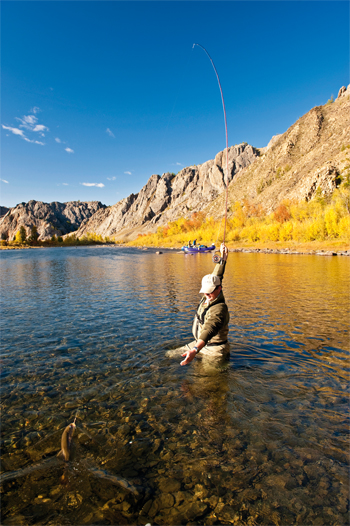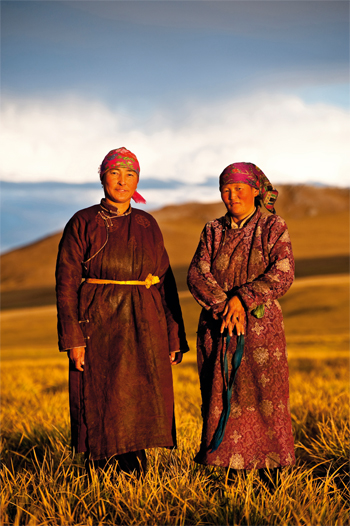What do you reckon qualifies as legendary fly fishing? Should qualification entail insane numbers of huge fish that crawl up the line and try to rip your arms off, or might the actual location and overall experience be as important as the fish you are trying to catch? How about chasing the world's largest trout species in a country as remote and under-populated as Mongolia? Henry Gilbey investigates.
Fishing for taimen – a legendary occupation
Rafting down and camping in deserted river valleys that seem to be almost off the edge of the known world and trying to catch a species of fish as majestic as the taimen qualifies as legendary in my book.
Stories of fishing for taimen used to revolve around a lot of bouncing about in either old Russian helicopters or old Russian military trucks, so it was with some degree of relief that we noted two classic Toyota Land Cruisers waiting to pick us up at Murun airport.
Hell, I could even see a Tarmac road leading out of what might be termed the car park. We immediately turned right, though, and the Tarmac ended after no more than a hundred glorious yards. Our Mongolian drivers steered on to the vast open plains known as the steppe as confidently as you like. Some five hours away lay the Delger-Muron river. I was finally in Outer Mongolia. (Read more on fishing abroad here.)
Loopy taimen
We spent the first night in a fixed ger camp on the side of the river, where a basic but efficient wood-burning stove kept us nice and warm. It was not until I stumbled out of the ger early the following morning that Mongolia came along and gave me a proverbial smack in the face. What met me was about as stunning a location as I have ever seen.
None of us could be classed as experienced campers but we very quickly fell into a routine that allowed us to maximise fly fishing time and enjoy our downtime in this wilderness. I desperately wanted to see a big taimen on the first morning, but it was very quickly obvious that we were going to have to work at it. Apparently, when river levels hover between fishable and unfishable the taimen can go loopy for a week or so, but for the most part there simply aren’t loads and loads of them in the rivers and they take a degree of catching. If we’d needed to let off steam and fill our boots with fish we could have put down the taimen gear and smashed any number of lenok and grayling. Indeed, the lenok fishing on its own is like a world-class trout fishing experience. But we were here to fly fish for taimen.
High spirits
We did not see a taimen on that first day, but spirits were high as the camp-fire was lit, supper was cooked for us and we sat around and talked the usual meaningful fishing stuff as the temperature plummeted and the stars lit up the vast sky. A good number of lenok had been taken right in front of the camping spot, up to perhaps 5lb, but the taimen had resolutely kept their noses clean.
There is no getting away from the fact that those nights under canvas were cold. Although we were there right at the start of autumn, I was braving the great outdoors in my tent (that I hadn’t had to put up), wrapped up in sleeping bag effective to -15°C, full thermals and thick socks plus a fleece hat. That first night I lay there cursing what I presumed was heavy rain, and hoping for more of those never-ending intensely blue skies and fluffy white clouds. Plus some taimen, of course. When I unzipped the canvas, having braced myself, I stepped outside to a landscape that looked very different to how it had the previous afternoon. Where had all that snow come from? So that was the “rain” during the night. I have never been anywhere with such a range of temperature fluctuations as Mongolia; you can be shivering in the middle of the night and then soaking up 20°C-plus of sunshine over lunch.
Fishing double-handed rods
I guess the world just felt a bit different that snow-covered morning. Spirits were soaring. By the time we had wolfed down a hot breakfast and begun gearing up and heading off downriver, the snow had already begun to melt and the sun was sneaking over the high sides of the valley. We spent the morning fishing double-handed rods down a stunning-looking run, and I saw a big taimen move beneath us as we floated down into position. Lunch was taken beneath a warming blue sky, and I witnessed my first taimen hooked but lost shortly afterwards. I then decided to take myself off downstream and catch up with Stuart Forsyth and Ian Reilly who were fly fishing a mile or so below us. I timed it perfectly – Stuart was hooked up to a taimen on his big 14ft double-handed fly fishing rod. It was hardly a monster, but to see such a pristine fish come out of such an environment was a hugely special moment.
Territorial taimen
I saw another couple of medium-sized taimen come to Ian’s shallow diving lure the following afternoon, plus numerous frustration-releasing lenok to the light single-handed fly fishing rods, but still the big taimen eluded us. Taimen are territorial fish and our guides knew exactly where the fish were most likely to be lying. But big taimen don’t get big around here by being stupid. Granted, there are some amazing stories out there of giant fish attacking all manner of little animals swimming innocently across the river (mice, rats, squirrels, you name it, these things eat them), but there is no substitute for putting your fly or lure in the right areas as often as you can.
After the dump of snow the weather had settled right down. Each morning now started off cold, frosty and achingly clear and bright. Andy Parkinson was adamant that big taimen like more settled weather, and considering that the guy lives in Mongolia and runs the company Fish Mongolia, I was inclined to take his word for it. That morning Peter McLeod spotted a sizeable lone fish sitting high up in the water as the guys drifted on through a long pool on their way to the next camping spot. I was in the boat behind, getting terribly overexcited at the sight of such a fish nonchalantly moving through the pool. Without any thought for his own fly fishing, Peter called the fish out to his brother Alex, who in a split second had put an enticing-looking tan gurgler a couple of feet in front of the fish and was drawing the dry fly seductively across the water. The wake on these flies was mesmerising enough to us, let alone the fish. None of us could really believe that a big old lone fish like this would even sniff at a fly with a couple of boats drifting through his terrain, but it just came on over all nice and easy, turned a couple of times, and then simply inhaled the gurgler right off the top.
The actual fight was hardly that spectacular; indeed the taimen didn’t seem massively bothered until steady pressure brought the fish closer to the bank. Sure, it made some powerful, telling runs but I did not sense that at any time Alex felt out of control. Sometimes they go nuts and I hear they can jump clean out of the water; sometimes they seem just to sulk and hang out there in the current. Whatever they do, though, I can’t get over what a special fish they are. Cradling 125cm or roughly 35lb of fish in your hands brings the whole Mongolia experience into sharp focus.
Soul capturing
The nearer the trip drew to ending, the more I really didn’t want it to. I was getting used to camping out in the middle of nowhere. The natural rhythm of fishing and living out there was fast becoming “normal” for want of a better word. Life just moves to a different rhythm in Outer Mongolia. I guess that this legendary taimen fly fishing kind of creeps up on you and captures a part of your soul forever.
What to take fishing for taimen
Fly-fishing is encouraged but by all means take a lure rod and a few lures. You will be asked to replace the trebles with a barbless single hook. (Try it out before you travel.) Certain kinds of single-hooked soft plastics that you could bounce and twitch through the runs and pools would work well for taimen.
Fly-fishing gear
A 9- or 10-weight double-handed rod, plus reel to match. Don’t worry if your Speycasting is not up to much; there is stacks of water where it is not required.
A 9- or 10-weight single-handed fly fishing rod, plus reel to match – for certain bank-fishing applications, and rafting down the river.
A 4- or a 5-weight single-handed fly fishing rod, plus reel to match, for the lenok and grayling fishing. A floating and an intermediate line, plus Chernobyl Ants, stimulators, hoppers and a selection of the more regular nymphs; 4lb-6lb leader works well for lenok and grayling. Both floating and sinking lines are used for taimen – take a fly line with changeable tips. Skagit lines (with short shooting heads) are good for punching large flies a decent distance, and they make life easier if you are not used to double-handed fly rods.
Look at 16lb-20lb leaders for taimen. Their favourite surface flies are the Gurgler and the Titanic. Also think about large poppers, deer-hair mouse imitations and oversized Chernobyl Ants. Large streamers also do well, especially “lenok” patterns. Olive is the best colour, but white and black streamers work, too. Traditional tube flies for salmon fishing can take taimen, and I reckon the hitch flies used in Iceland might turn them on.
What to wear
Be prepared for temperature fluctuations; layers allow you to put on and take off depending on how hot or cold it is. Since you will be clambering in and out of rubber rafts, make sure to take wading boots without metal studs on.
A really good pair of breathable chest waders is vital, as is a small tube of Aquasure in case of any mishaps. Start off underneath the waders with a good pair of tight- fitting, lightweight thermal tights or running trousers, and then layer accordingly on top of that. Bear in mind that you might end up walking a fair bit.
A decent waterproof wading jacket is as important as a good pair of waders and wading boots. You can wear what you need to underneath it. At the very minimum, take a lightweight and a heavier-weight fleece, thermal undergarments, hat, gloves and some kind of neck warmer. Make sure to take thermal socks as well, plus a pair of shoes for when you’re wandering around camp.
Fly-fishing for taimen and lenok- how to get there
Aardvark McLeod arranges fly-fishing holidays all over the world.
The firm offers saltwater and freshwater fly-fishing in locations such as Africa, Alaska, Seychelles, Bahamas, Argentina, Venezuela, Belize, Canada, Costa Rica, Cuba, Iceland and Norway.
This article was originally published in 2010 and has been updated.







